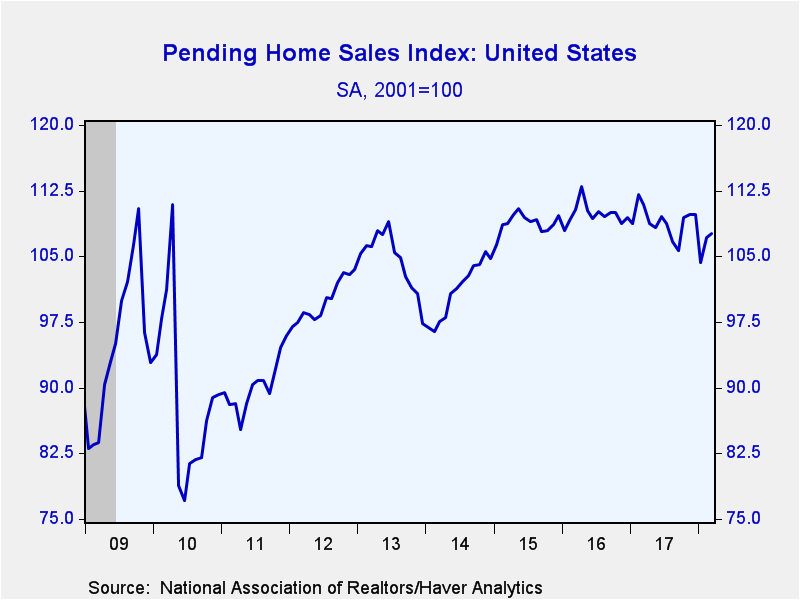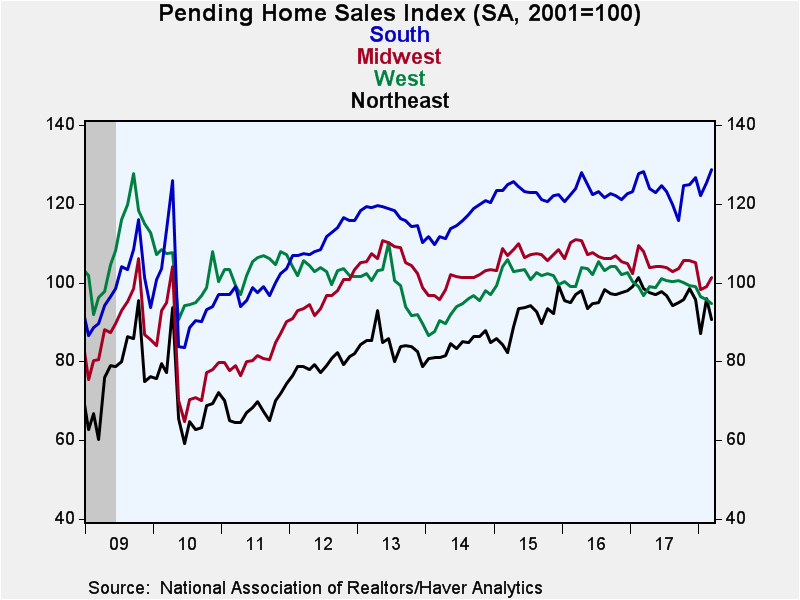 Global| Apr 30 2018
Global| Apr 30 2018U.S. Pending Home Sales Edge Up in March
Summary
The National Association of Realtors (NAR) reported that pending sales of existing homes increased 0.4% (-3.0% year-on-year) in March to an index level of 107.6 (2001=100). Sales have slowed somewhat with the first quarter averaging [...]
The National Association of Realtors (NAR) reported that pending sales of existing homes increased 0.4% (-3.0% year-on-year) in March to an index level of 107.6 (2001=100). Sales have slowed somewhat with the first quarter averaging 106.4 versus 109.7 in the fourth quarter and 108.9 for the entirety of 2017. The National Association of Realtors noted that while demand is strong, buyers are constrained by a limited inventory of housing. One indicator of that inventory constraint is the months' supply of new single-family homes, which declined to 5.2 months in March, below the 45-year median of 5.8 months.
Pending sales rose 2.4% (-6.0% y/y) in the Midwest and 2.5% (0.3 y/y) in the South. Meanwhile sales in the Northeast dropped 5.6% (-8.1% y/y) and were down 1.1% (-2.2%) in the West. Pending sales in the South are at their highest level in 12 years, while sales in the West touched a nearly four-year low.
The pending home sales index measures when the sales contract for an existing home is signed, analogous to the Census Bureau's new home sales data. In contrast, the National Association of Realtors' existing home sales data are recorded when the sale is closed. In developing the pending home sales index, the NAR found that the level of monthly sales contract activity parallels the level of closed existing home sales in the following two months. The series dates back to 2001, and the data are available in Haver's PREALTOR database. The months' supply of new single-family houses for sale dates back to 1963 and can be found in the USECON database.
| Pending Home Sales (SA, 2001=100) | Mar | Feb | Jan | Mar Y/Y % | 2017 | 2016 | 2015 |
|---|---|---|---|---|---|---|---|
| Total | 107.6 | 107.2 | 104.3 | -3.0 | 108.9 | 110.2 | 108.9 |
| Northeast | 90.6 | 96.0 | 87.0 | -8.1 | 97.1 | 96.4 | 97.1 |
| Midwest | 101.3 | 98.9 | 98.2 | -6.0 | 104.7 | 107.9 | 104.7 |
| South | 128.6 | 125.5 | 122.0 | 0.3 | 123.6 | 123.3 | 123.6 |
| West | 94.7 | 95.8 | 96.5 | -2.2 | 99.4 | 102.7 | 99.4 |
Gerald D. Cohen
AuthorMore in Author Profile »Gerald Cohen provides strategic vision and leadership of the translational economic research and policy initiatives at the Kenan Institute of Private Enterprise.
He has worked in both the public and private sectors focusing on the intersection between financial markets and economic fundamentals. He was a Senior Economist at Haver Analytics from January 2019 to February 2021. During the Obama Administration Gerald was Deputy Assistant Secretary for Macroeconomic Analysis at the U.S. Department of Treasury where he helped formulate and evaluate the impact of policy proposals on the U.S. economy. Prior to Treasury, he co-managed a global macro fund at Ziff Brothers Investments.
Gerald holds a bachelor’s of science from the Massachusetts Institute of Technology and a Ph.D. in Economics from Harvard University and is a contributing author to 30-Second Money as well as a co-author of Political Cycles and the Macroeconomy.







